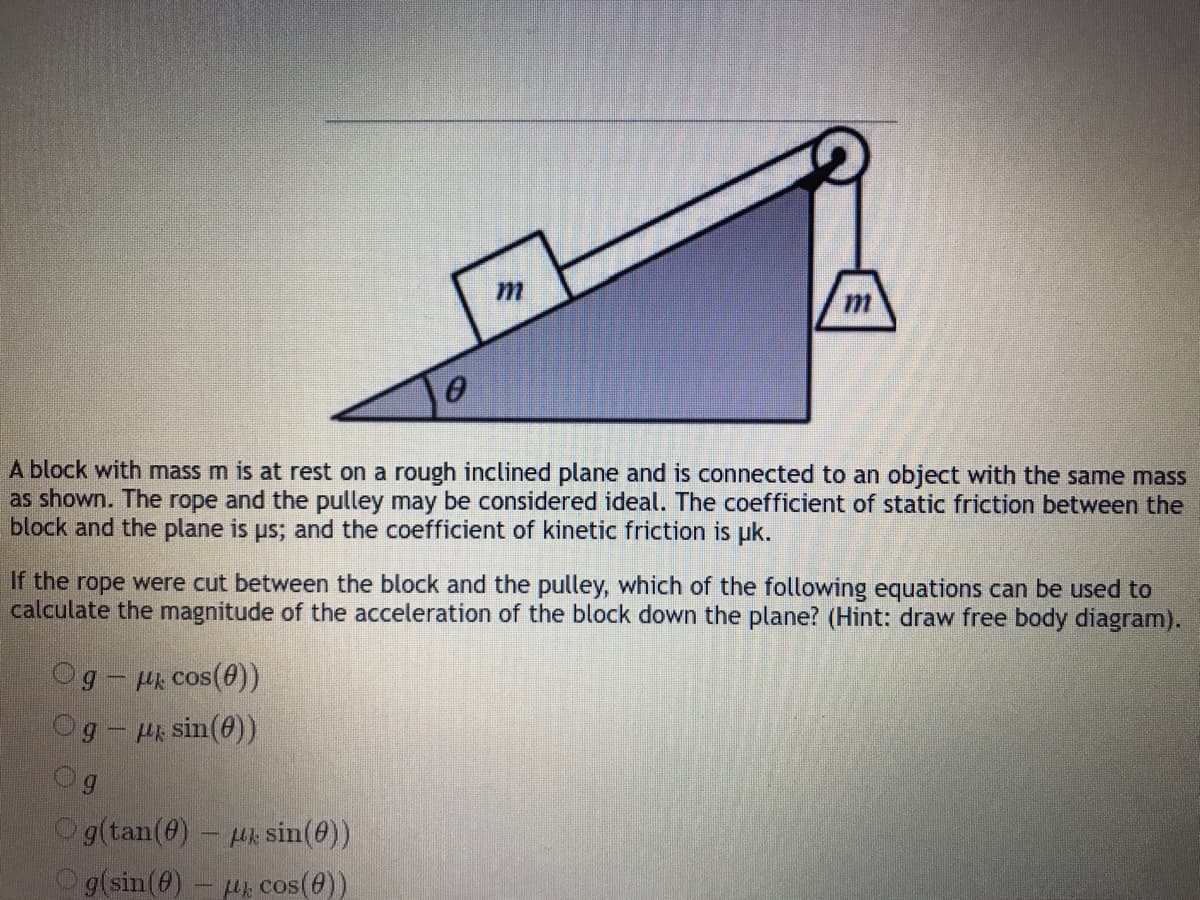m A block with mass m is at rest on a rough inclined plane and is connected to an object with the same mass as shown. The rope and the pulley may be considered ideal. The coefficient of static friction between the block and the plane is ps; and the coefficient of kinetic friction is uk. If the rope were cut between the block and the pulley, which of the following equations can be used to calculate the magnitude of the acceleration of the block down the plane? (Hint: draw free body diagram). Og- Hk cos(0)) Og- P sin(0)) Og Og(tan(e)- Hk sin(@)) Og(sin(0)- u cos(0))
m A block with mass m is at rest on a rough inclined plane and is connected to an object with the same mass as shown. The rope and the pulley may be considered ideal. The coefficient of static friction between the block and the plane is ps; and the coefficient of kinetic friction is uk. If the rope were cut between the block and the pulley, which of the following equations can be used to calculate the magnitude of the acceleration of the block down the plane? (Hint: draw free body diagram). Og- Hk cos(0)) Og- P sin(0)) Og Og(tan(e)- Hk sin(@)) Og(sin(0)- u cos(0))
University Physics Volume 1
18th Edition
ISBN:9781938168277
Author:William Moebs, Samuel J. Ling, Jeff Sanny
Publisher:William Moebs, Samuel J. Ling, Jeff Sanny
Chapter6: Applications Of Newton's Laws
Section: Chapter Questions
Problem 124AP: As shown below, the coefficient of kinetic friction between the surface and the larger block is...
Related questions
Question

Transcribed Image Text:A block with mass m is at rest on a rough inclined plane and is connected to an object with the same mass
as shown. The rope and the pulley may be considered ideal. The coefficient of static friction between the
block and the plane is ps; and the coefficient of kinetic friction is uk.
If the rope were cut between the block and the pulley, which of the following equations can be used to
calculate the magnitude of the acceleration of the block down the plane? (Hint: draw free body diagram).
g-Hk cos(e))
Og- P sin(0)
Og
Og(tan(0) Hk sin(@))
Og(sin(0)- u cos(0))
Expert Solution
This question has been solved!
Explore an expertly crafted, step-by-step solution for a thorough understanding of key concepts.
This is a popular solution!
Trending now
This is a popular solution!
Step by step
Solved in 2 steps with 2 images

Knowledge Booster
Learn more about
Need a deep-dive on the concept behind this application? Look no further. Learn more about this topic, physics and related others by exploring similar questions and additional content below.Recommended textbooks for you

University Physics Volume 1
Physics
ISBN:
9781938168277
Author:
William Moebs, Samuel J. Ling, Jeff Sanny
Publisher:
OpenStax - Rice University

Physics for Scientists and Engineers: Foundations…
Physics
ISBN:
9781133939146
Author:
Katz, Debora M.
Publisher:
Cengage Learning

University Physics Volume 1
Physics
ISBN:
9781938168277
Author:
William Moebs, Samuel J. Ling, Jeff Sanny
Publisher:
OpenStax - Rice University

Physics for Scientists and Engineers: Foundations…
Physics
ISBN:
9781133939146
Author:
Katz, Debora M.
Publisher:
Cengage Learning